
Stratus Vineyards is methodical in pretty much everything it does.
From vineyard management to winemaking and ultimately the release of the wines, this benchmark winery operates much like the sleek lines of the architectural marvel that juts from the vineyards at its home in Niagara-on-the-Lake — with purposeful precision.
The driving principal, the philosophy behind Stratus, is a top-down approach. The signature Stratus Red and Stratus White blends are dealt with first and then everything falls into place after that. The careful barrel and lot selection is conducted with military precision.
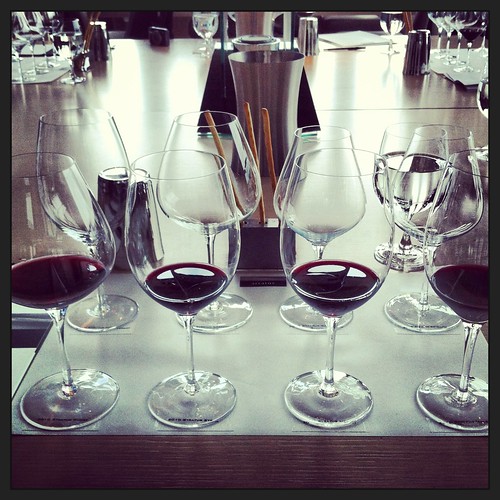
The two top blends determine what will be made below that each and every vintage and the percentage of the blends sets the tone for the production of each of the single varietals in every vintage. The “supporting cast” is generally low production lots, between 150 and 300 cases, and always unpredictable.
Where it gets interesting is in how each variety will be made in any given vintage.
Take 2010, for instance. A long, sweltering and relatively dry growing season in Niagara made picking a challenge for winemaker J.L. Groux who likes to harvest very late into the season. But even with the heat, while most of Niagara’s Chardonnay was long plucked from the vine, Groux brought in the Stratus Chard on Nov. 15. Sauvignon Blanc came in on Oct. 13 and Semillon on Nov. 2. On the red side, Merlot, Petit Verdot and Gamay came in Oct. 25 with Syrah and Malbec on Nov. 3.
Now think about that. Chardonnay on Nov. 15, after the red varieties. I recall some wineries in the fall of 2010 bringing in Chardonnay at the end of August and certainly most was done by the end of September.
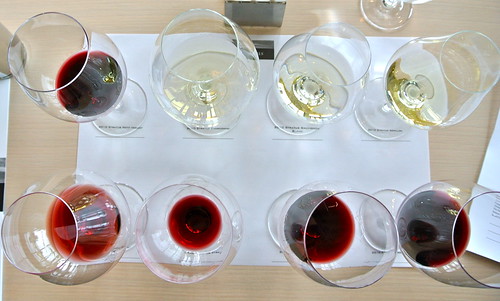
Sticking with the Chardonnay train of thought, there’s no question the fruit was ripe, I would say it couldn’t get any riper if you pick in November after a long, hot summer, but how does Groux and consultant Paul Hobbs treat the fruit after that?
It was 100% barrel fermented for 303 days in 100% new French oak. It also (and here’s where it gets real interesting) underwent 100% malolactic fermentation, a process that gives white wines a creamier feel and also can reduce the natural acidity in the wine.
 I asked Groux about this during a tasting of the new spring releases from Stratus and he said his preference was for partial malo but consultant Hobbs elected full malo. Hobbs won the argument, but Groux says now that he’s glad they went with Hobs’ suggestion.
I asked Groux about this during a tasting of the new spring releases from Stratus and he said his preference was for partial malo but consultant Hobbs elected full malo. Hobbs won the argument, but Groux says now that he’s glad they went with Hobs’ suggestion.
“It’s not Burgundy and it’s not California,” says Groux. “It’s Niagara. We tried to find the right balance.”
I’m a little bit conflicted with this wine. I see lots of California in it but not a lot of Niagara. It’s a voluptuous, super-ripe, highly extracted, richly spiced and fleshy Chardonnay that wouldn’t be out of place in the heart of Napa Valley from fruit grown in Carneros.
To me, it seems to be a lot of Hobbs and just a little Groux, and I don’t mean that to sound negative, because Hobbs is a brilliant winemaker. I say it because a lot of the Niagara, that lovely fresh acidity and core of minerality, has somehow been lost in this wine.
Quite simply, it’s a fruit bomb that jumps out of the gate at its peak of perfection with a wide range of California descriptors (that word voluptuous keeps popping into my head) that will attract many fans of this style of Chardonnay.
But it’s not Niagara. Sorry, but it’s not.
That’s a crazy thing to say, I know, because, yes, it was grown here and made here so, of course, it’s Niagara. I just think the Niagara part is buried deep in stylistic decisions that have skewed those qualities we associate with Ontario Chardonnay. I would never pick this wine out in a blind tasting as being from Niagara-on-the-Lake, Niagara, Ontario or even Canada. New World, yes, but Niagara, no.
The 2010 Chard from Stratus was (is?) a fascinating study for me. The 2009 version, made similarly, was rated 93 points by me and it was definitely one of the top Chardonnays I tasted last year. But the vintage was cooler, the fruit not as ripe despite being picked on the cusp of winter and the malo not has influential on the wine. The minerals rose above the fray, the acid provided some balance and it will develop further in the bottle. Time will tell if the 2010 will stand the test of time, but my gut says to enjoy it now, in its youth.
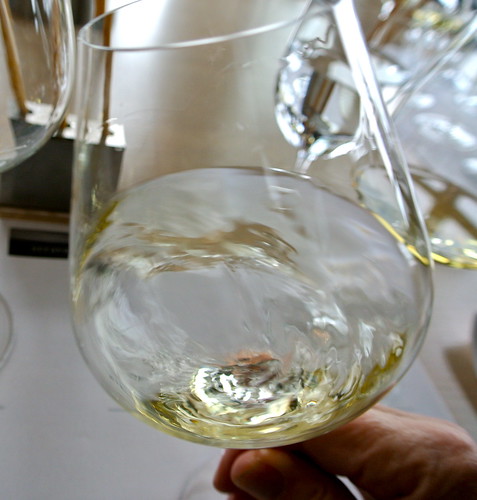
The spring tasting at Stratus was an enjoyable morning of tasting and discussing the wines with Groux. There are some real gems with the release, most being made available this spring.
We were also treated to a spectacular lunch prepared by Niagara chef Ryan Crawford that was matched to more Stratus wines.
Here’s what we tasted:
Stratus Gamay 2010 ($29, winery now, 89 points) — Groux has taken a different approach to this grape than most Niagara winemakers. It’s low yield (1.2 tonnes per acre), late picked (Oct. 25), sees 584 days of French oak (37% in second-fill barrels) and is made in a bold, structured style and not the fruity, fresh style we have seen lately. The nose shows ripe berry, cherry-strawberry, licorice, red plum and an array of spices on the nose. It’s quite firm and structured on the palate with evident tannins, bold fruits, savoury spices and grip through the finish.
 Stratus Syrah 2010 ($48, winery, 92 points) — Similar oak treatment as the Gamay, this Syrah is the superstar in the lineup. It’s has a complex and gorgeous nose of cassis, earth, pepper, forest floor, bacon fat, sweet oak spices and black currants. It’s tight and highly structured on the palate with concentrated black fruits, roasted meats, cracked peppercorns, lovely cocoa, dusty tannins and length and power through the finish. This is one to tuck away and savour for many years.
Stratus Syrah 2010 ($48, winery, 92 points) — Similar oak treatment as the Gamay, this Syrah is the superstar in the lineup. It’s has a complex and gorgeous nose of cassis, earth, pepper, forest floor, bacon fat, sweet oak spices and black currants. It’s tight and highly structured on the palate with concentrated black fruits, roasted meats, cracked peppercorns, lovely cocoa, dusty tannins and length and power through the finish. This is one to tuck away and savour for many years.
Stratus Merlot 2010 ($32, May release, 91 points) — When Stratus first starting farming its Merlot block the yields were upwards of 10 tonnes per acre. Today it’s more like two tonnes per acre. The nose is pretty and perfumed with red currants, plums, raspberry-cherry fruit, cedar smoke and backed up by lovely complementing nutmeg/cinnamon spices. This is elegant and pretty, rather than earthy and meaty, with concentrated red fruits and beautiful spices that linger through the long finish. Very fine.
Stratus Malbec 2010 ($48, June release, 89 points) — Malbec is still a novelty wine in Niagara, in my opinion, but Stratus is certainly doing its part in elevating its status as a viable option for Ontario winemakers. A lot of that has do with the influence of consultant Paul Hobbs in partnership with J.L. Groux. The 2010 version has a floral, raspberry, almost jammy nose with soft baking spices and light roasted vanilla bean notes. It’s still a baby and needs the gift of time, but starting to show a palate of red fruits, blueberries with touches of anise, licorice, spice, decent acidity and soft tannic structure.
Stratus Petit Verdot 2010 ($38, August release, 88 points) — Primarily planted to feed the main assemblage for the Stratus Red, Petit Verdot as this level can be quite exciting. The nose is earthy and funky with dark fruits, thick black cherry and black currants, anise, dark chocolate and baking spices. It’s made with nearly 15% alcohol and you can feel a little heat on the finish but still has attractive dark fruits, loam, firm tannins and structure. Will need time to show itself better.
 Stratus Chardonnay 2010 ($55, July release, 90 points) — As noted in the intro above, I’m not quite sure how to rate this wine. For lovers of the full-out, ripe, luxurious and fleshy style of Chardonnay that this is, I would give it more than 90 points. But for those who prefer some freshness, minerality and sense of terroir, I would give it slightly less points. So, we meet in the middle. The nose is bold with poached pear, vanilla and cream, lush tropical fruits, caramel, juicy apple fruit and buttered toast. It’s robust and substantial on the palate with a fleshy array of tropical fruits, voluptuous pear and vanilla, buttery notes and an altogether hedonistic and juicy-extracted feel through the finish. It has 14.5% alcohol and soft acid. Drink sooner, rather than later, but enjoy the opulent style in which it is presented.
Stratus Chardonnay 2010 ($55, July release, 90 points) — As noted in the intro above, I’m not quite sure how to rate this wine. For lovers of the full-out, ripe, luxurious and fleshy style of Chardonnay that this is, I would give it more than 90 points. But for those who prefer some freshness, minerality and sense of terroir, I would give it slightly less points. So, we meet in the middle. The nose is bold with poached pear, vanilla and cream, lush tropical fruits, caramel, juicy apple fruit and buttered toast. It’s robust and substantial on the palate with a fleshy array of tropical fruits, voluptuous pear and vanilla, buttery notes and an altogether hedonistic and juicy-extracted feel through the finish. It has 14.5% alcohol and soft acid. Drink sooner, rather than later, but enjoy the opulent style in which it is presented.
Stratus Sauvignon Blanc 2010 ($29, June release, 92 points) — One of the main ingredients that makes the Stratus White assemblage such a beautiful wine. It’s aged in mostly used French barrels for 578 days and made at only 12% alcohol. I love this wine. A sensational nose of gooseberry, garden herbs, sweet grass notes, boxwood, tropical fruits and lovely oak spices that meld perfectly with the mature fruit. A seam of minerality shows through the ripe tropical fruits and there is a gentle core of acidity that keeps the flavours fresh. It’s all highlighted by a subtle spiciness on the finish.
Stratus Semillon 2010 ($32, May release, 90 points) — Aged 558 days in French oak, 25% of which was new. Stratus used to pick this varietal before Sauvingon Blanc but now is picked later to concentrate the flavours that this grape is capable of. It is classic Semillon with a waxy/lanoline nose of pear, melon, citrus and tropical fruits with underlying spice and honey notes. Quite racy and energetic on the palate with succulent grapefruit, melon, pineapple and pear fruits lifted by subtle oak spices. Should age nicely and develop lovely secondary flavours and spice.
***
Lunch by Chef Ryan Crawford
Ryan Crawford told us over the lunch he prepared at the winery that he’s staying put in Niagara and will be part of the new Redstone Winery that Moray Tawse is building at the old Thomas & Vaughan site on Old Highway 8, just across the road from Malivoire. He’s moving from his comfortable digs in Port Dalhousie to Beamsville in the near future and will continue to thrill Niagarans with culinary skills.
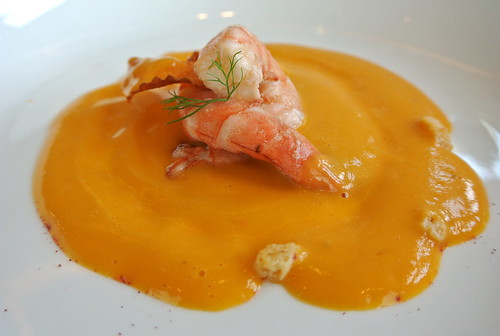
For his first course, Crawford served a sweet potato and prawn bisque with creme fraiche that was paired with the Stratus Gewurztraminer 2011 ($39, winery now). This was a delicious pairing that was punctuated by the sweet potato matching so brilliantly to the grapefruit, citrus, lychee and exotic spices the Gewurz brought to the pairing.
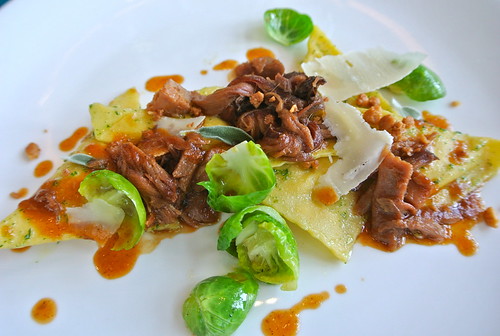
Next was the smoked ham hock ragu with peasse porridge ravioli, baby cabbage, sage puree and fried dough served with the Stratus Cabernet Franc 2009 ($38, June release). Smoked ham hock seems perfectly destined to match neatly with a savoury/sightly herbaceous Cab Franc such as this one even though Groux didn’t pick the grapes until early December of that year. There is plenty of ripe-ish red raspberry and cherry fruit and some lovely currants and spice that was stitched to the sage puree. Altogether a lovely match.
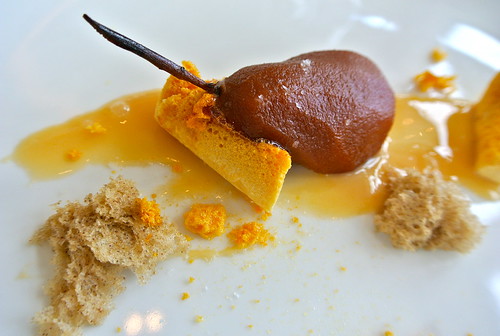
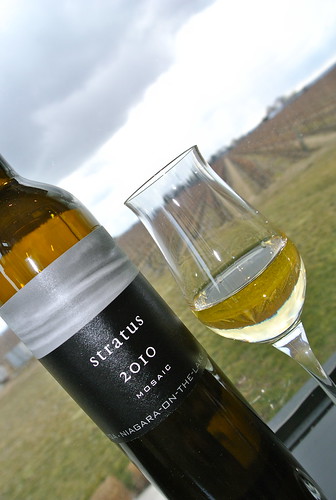
Crawford’s final piece to the puzzle was a caramel poached pear with white chocolate “snow,” dulce de leche and the coolest 30-second brioche, or as you may know it: Sponge toffee. It was as beautiful to look it as it was to chow down. The new Stratus Mosaic 2010 ($25 for 375 ml, winery) is a late harvest wine combining Riesling and Gewurztraminer. It’s likely a one-off wine for Stratus and, perhaps, not sweet enough to match the heavenly dessert prepared by Crawford, but interesting on its own for the fresh, semi-sweet citrus, grapefruit and subtle lychee nut and spice notes that caressed the palate. Can’t get my mind off that caramel poached pear.


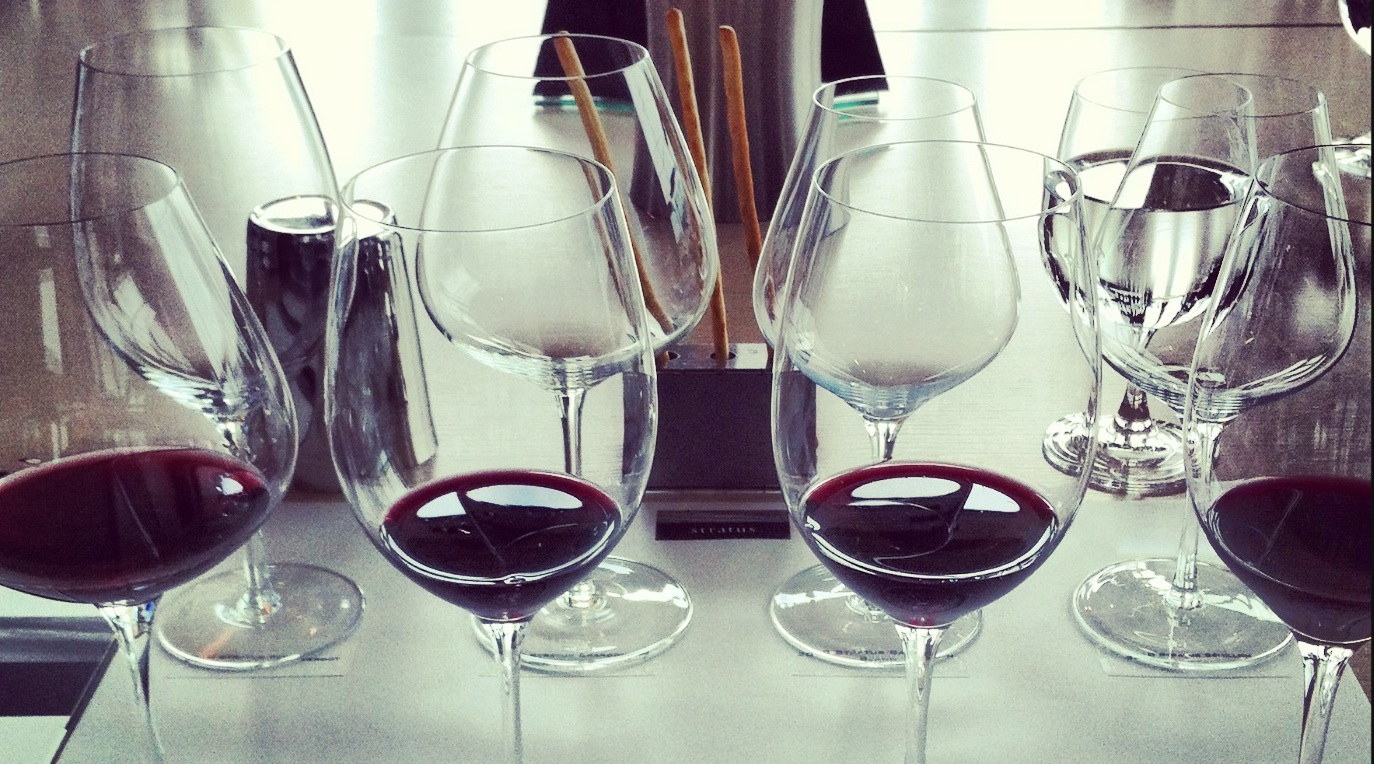





Not Niagara? On the contrary, Rick, I believe it is one of the first Chardonnays to show the full potential of the region. I did get the mine reality, liked the ever-so-slightly reduced acidity (there was plenty left) and truly appreciated the wild nose and taste of white fruits. I think it is spectacular. Not Californian, but better than Californian…fresher, lighter and wa-a-ay more delicious. I believe it will age very well too. I hope other Niagara winemakers will taste it and try to emulate the style.
Rick/Konrad, The vintage skews the discussion – has to. I’m certain Groux meant to make a Niagara Chardonnay full of minerality and laser-acidity but as he said “you had to go run and pick fast.” He still made a great wine, even if it does not clearly define its home. Tropical fruit dominant, certainly warm vintage Chard and blessed with great length. Talk again when the ’11 is released and the tune will surely change.
To read Michael’s Post on the Stratus 2010 lineup, go here: http://tiny.cc/ycaavw
Geez. Sounds like I will have to get some for the missus – she loves that style of wine!